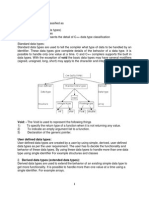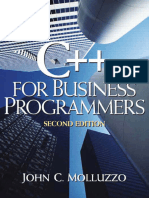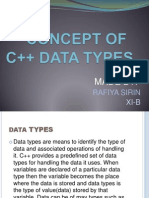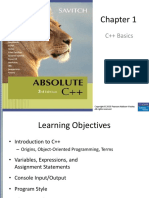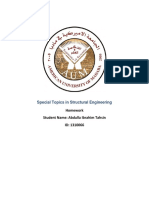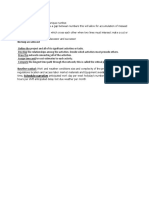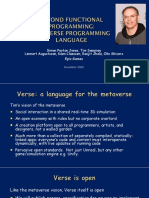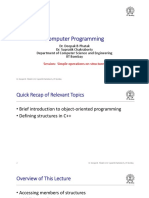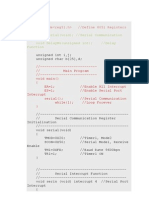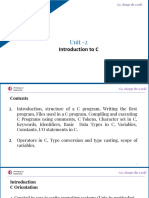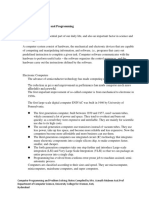Chapter 2 Elementary Programming
Copyright 2013 by Pearson Education, Inc. All Rights Reserved.
�Motivations
In the preceding chapter, you learned how to
create, compile, and run a program. Starting from
this chapter, you will learn how to solve practical
problems programmatically. Through these
problems, you will learn primitive data types and
related subjects, such as variables, constants, data
types, operators, expressions, and input and output.
Copyright 2013 by Pearson Education, Inc. All Rights Reserved.
�Objectives
To write C++ programs that perform simple computations (2.2).
To read input from the keyboard (2.3).
To use identifiers to name elements such as variables and functions (2.4).
To use variables to store data (2.5).
To program using assignment statements and assignment expressions (2.6).
To name constants using the const keyword (2.7).
To declare variables using numeric data types (2.8.1).
To write integer literals, floating-point literals, and literals in scientific notation (2.8.2).
To perform operations using operators +, -, *, /, and % (2.8.3).
To perform exponent operations using the pow(a, b) function (2.8.4).
To write and evaluate expressions (2.9).
To obtain the current system time using time(0) (2.10).
To use augmented assignment operators (+=, -=, *=, /=, %=) (2.11).
To distinguish between postincrement and preincrement and between postdecrement and
predecrement (2.12).
To convert numbers to a different type using casting (2.13).
To describe the software development process and apply it to develop the loan payment
program (2.14).
To write a program that converts a large amount of money into smaller (2.15).
To avoid common errors in elementary programming (2.16).
Copyright 2013 by Pearson Education, Inc. All Rights Reserved.
�Introducing Programming with an
Example
Listing 2.1 Computing the Area of a
Circle
This program computes the area of the
circle.
ComputeArea
Run
Copyright 2013 by Pearson Education, Inc. All Rights Reserved.
�animation
Trace a Program Execution
allocate memory
for radius
#include <iostream>
using namespace std;
radius
int main() {
double radius;
double area;
no value
// Step 1: Read in radius
radius = 20;
// Step 2: Compute area
area = radius * radius * 3.14159;
// Step 3: Display the area
cout << "The area is ";
cout << area << endl;
}
Copyright 2013 by Pearson Education, Inc. All Rights Reserved.
�animation
Trace a Program Execution
memory
#include <iostream>
using namespace std;
int main() {
double radius;
double area;
radius
no value
area
no value
// Step 1: Read in radius
radius = 20;
allocate memory
for area
// Step 2: Compute area
area = radius * radius * 3.14159;
// Step 3: Display the area
cout << "The area is ";
cout << area << std::endl;
}
Copyright 2013 by Pearson Education, Inc. All Rights Reserved.
�animation
Trace a Program Execution
assign 20 to radius
#include <iostream>
using namespace std;
radius
int main() {
double radius;
double area;
area
20
no value
// Step 1: Read in radius
radius = 20;
// Step 2: Compute area
area = radius * radius * 3.14159;
// Step 3: Display the area
cout << "The area is ";
cout << area << std::endl;
}
Copyright 2013 by Pearson Education, Inc. All Rights Reserved.
�animation
Trace a Program Execution
#include <iostream>
using namespace std;
memory
radius
int main() {
double radius;
double area;
area
// Step 1: Read in radius
radius = 20;
20
1256.636
compute area and assign
it to variable area
// Step 2: Compute area
area = radius * radius * 3.14159;
// Step 3: Display the area
cout << "The area is ";
cout << area << std::endl;
}
Copyright 2013 by Pearson Education, Inc. All Rights Reserved.
�animation
Trace a Program Execution
#include <iostream>
using namespace std;
memory
radius
int main() {
double radius;
double area;
area
// Step 1: Read in radius
radius = 20;
20
1256.636
print a message to the
console
// Step 2: Compute area
area = radius * radius * 3.14159;
// Step 3: Display the area
cout << "The area is ";
cout << area << std::endl;
}
Copyright 2013 by Pearson Education, Inc. All Rights Reserved.
�Reading Input from the
Keyboard
You can use the cin object to read input from
the keyboard.
ComputeAreaWithConsoleInput
Run
Copyright 2013 by Pearson Education, Inc. All Rights Reserved.
10
�Reading Multiple Input in One Statement
ComputeAverage
Copyright 2013 by Pearson Education, Inc. All Rights Reserved.
Run
11
�Identifiers
An identifier is a sequence of characters that
consists of letters, digits, and underscores (_).
An identifier must start with a letter or an
underscore. It cannot start with a digit.
An identifier cannot be a reserved word. (See
Appendix A, C++ Keywords, for a list of
reserved words.)
An identifier can be of any length, but your C++
compiler may impose some restriction. Use
identifiers of 31 characters or fewer to ensure
portability.
Copyright 2013 by Pearson Education, Inc. All Rights Reserved.
12
�Variables
// Compute the first area
radius = 1.0;
area = radius * radius * 3.14159;
cout << area;
// Compute the second area
radius = 2.0;
area = radius * radius * 3.14159;
cout << area;
Copyright 2013 by Pearson Education, Inc. All Rights Reserved.
13
�Declaring Variables
int x;
// Declare x to be an
// integer variable;
double radius; // Declare radius to
// be a double variable;
char a;
// Declare a to be a
// character variable;
Copyright 2013 by Pearson Education, Inc. All Rights Reserved.
14
�Assignment Statements
x = 1;
// Assign 1 to x;
radius = 1.0;
// Assign 1.0 to radius;
a = 'A';
// Assign 'A' to a;
Copyright 2013 by Pearson Education, Inc. All Rights Reserved.
15
�Declaring and Initializing
in One Step
int x = 1;
double d = 1.4;
Copyright 2013 by Pearson Education, Inc. All Rights Reserved.
16
�Named Constants
const datatype CONSTANTNAME = VALUE;
const double PI = 3.14159;
const int SIZE = 3;
Copyright 2013 by Pearson Education, Inc. All Rights Reserved.
17
�Numerical Data Types
Name
Synonymy
short
short int
215 to 2151 (-32,768 to 32,767)
16-bit signed
unsigned short
unsigned short int
0 to 2161 (65535)
16-bit unsigned
int
signed
unsigned
signed
long
unsigned int
0 to 2321 (4294967295)
long int
231 (-2147483648) to 2311 (2147483647) 32-bit signed
unsigned long
unsigned long int
0 to 2321 (4294967295)
263 (-9223372036854775808) to
2631 (9223372036854775807)
long long
Range
Storage Size
231 to 2311 (-2147483648 to 2147483647) 32-bit
32-bit unsigned
32-bit unsigned
64-bit signed
float
Negative range:
-3.4028235E+38 to -1.4E-45
Positive range:
1.4E-45 to 3.4028235E+38
double
Negative range:
64-bit IEEE 754
-1.7976931348623157E+308 to -4.9E-324
Positive range:
4.9E-324 to 1.7976931348623157E+308
long double
Negative range:
-1.18E+4932 to -3.37E-4932
Positive range:
3.37E-4932 to 1.18E+4932
Significant decimal digits: 19
Copyright 2013 by Pearson Education, Inc. All Rights Reserved.
32-bit IEEE 754
80-bit
18
�sizeof Function
You can use the sizeof function to find the size of a type.
For example, the following statement displays the size of
int, long, and double on your machine.
cout << sizeof(int) << " " << sizeof(long) << " " <<
sizeof(double);
Copyright 2013 by Pearson Education, Inc. All Rights Reserved.
19
�Synonymous Types
short int is synonymous to short. unsigned short int
is synonymous to unsigned short. unsigned int is
synonymous to unsigned. long int is synonymous to
long. unsigned long int is synonymous to unsigned
long. For example,
short int i = 2;
is same as
short i = 2;
Copyright 2013 by Pearson Education, Inc. All Rights Reserved.
20
�Numeric Literals
A literal is a constant value that appears directly in
a program. For example, 34, 1000000, and 5.0 are
literals in the following statements:
int i = 34;
long k = 1000000;
double d = 5.0;
Copyright 2013 by Pearson Education, Inc. All Rights Reserved.
21
�octal and hex literals
By default, an integer literal is a decimal number.
To denote an octal integer literal, use a leading 0
(zero), and to denote a hexadecimal integer literal,
use a leading 0x or 0X (zero x). For example, the
following code displays the decimal value 65535
for hexadecimal number FFFF and decimal value 8
for octal number 10.
cout << 0xFFFF << " " << 010;
Copyright 2013 by Pearson Education, Inc. All Rights Reserved.
22
�double vs. float
The double type values are more accurate than the
float type values. For example,
cout << "1.0 / 3.0 is " << 1.0 / 3.0 << endl;
displays 1.0 / 3.0 is 0.33333333333333331
16 digits
cout << "1.0F / 3.0F is " << 1.0F / 3.0F << endl;
Copyright 2013 by Pearson Education, Inc. All Rights Reserved.
23
�why called floating-point?
The float and double types are used to represent
numbers with a decimal point. Why are they called
floating-point numbers? These numbers are stored
into scientific notation. When a number such as
50.534e+1 is converted into scientific notation such
as 5.0534, its decimal point is moved (i.e., floated)
to a new position.
Copyright 2013 by Pearson Education, Inc. All Rights Reserved.
24
�Numeric Operators
Name
Meaning
Example
Result
Addition
34 + 1
35
Subtraction
34.0 0.1
33.9
Multiplication
300 * 30
9000
Division
1.0 / 2.0
0.5
Remainder
20 % 3
Copyright 2013 by Pearson Education, Inc. All Rights Reserved.
25
�Integer Division
+, -, *, /, and %
5 / 2 yields an integer 2.
5.0 / 2 yields a double value 2.5
5 % 2 yields 1 (the remainder of the division)
Copyright 2013 by Pearson Education, Inc. All Rights Reserved.
26
�Remainder Operator
Remainder is very useful in programming. For example, an
even number % 2 is always 0 and an odd number % 2 is always
1. So you can use this property to determine whether a number
is even or odd. Suppose today is Saturday and you and your
friends are going to meet in 10 days. What day is in 10
days? You can find that day is Tuesday using the following
expression:
Saturday is the 6th day in a week
A week has 7 days
(6 + 10) % 7 is 2
The 2nd day in a week is Tuesday
After 10 days
Copyright 2013 by Pearson Education, Inc. All Rights Reserved.
27
�Example: Displaying Time
Write a program that obtains hours and
minutes from seconds.
DisplayTime
Run
Copyright 2013 by Pearson Education, Inc. All Rights Reserved.
28
�Exponent Operations
cout << pow(2.0, 3) << endl; // Display 8.0
cout << pow(4.0, 0.5) << endl; // Display 2.0
cout << pow(2.5, 2) << endl; // Display 6.25
cout << pow(2.5, -2) << endl; // Display 0.16
Copyright 2013 by Pearson Education, Inc. All Rights Reserved.
29
�Problem: Monetary Units
This program lets the user enter the amount in
decimal representing dollars and cents and output
a report listing the monetary equivalent in single
dollars, quarters, dimes, nickels, and pennies.
Your program should report maximum number of
dollars, then the maximum number of quarters,
and so on, in this order.
ComputeChange
Copyright 2013 by Pearson Education, Inc. All Rights Reserved.
Run
30
�Trace ComputeChange
Suppose amount is 11.56
int remainingAmount = (int)(amount * 100);
remainingAmount
// Find the number of one dollars
int numberOfOneDollars = remainingAmount / 100;
remainingAmount = remainingAmount % 100;
1156
remainingAmount
initialized
// Find the number of quarters in the remaining amount
int numberOfQuarters = remainingAmount / 25;
remainingAmount = remainingAmount % 25;
// Find the number of dimes in the remaining amount
int numberOfDimes = remainingAmount / 10;
remainingAmount = remainingAmount % 10;
// Find the number of nickels in the remaining amount
int numberOfNickels = remainingAmount / 5;
remainingAmount = remainingAmount % 5;
// Find the number of pennies in the remaining amount
int numberOfPennies = remainingAmount;
Copyright 2013 by Pearson Education, Inc. All Rights Reserved.
31
�animation
Trace ComputeChange
Suppose amount is 11.56
int remainingAmount = (int)(amount * 100);
remainingAmount
// Find the number of one dollars
int numberOfOneDollars = remainingAmount / 100;
remainingAmount = remainingAmount % 100;
numberOfOneDollars
// Find the number of quarters in the remaining amount
int numberOfQuarters = remainingAmount / 25;
remainingAmount = remainingAmount % 25;
1156
11
numberOfOneDollars
assigned
// Find the number of dimes in the remaining amount
int numberOfDimes = remainingAmount / 10;
remainingAmount = remainingAmount % 10;
// Find the number of nickels in the remaining amount
int numberOfNickels = remainingAmount / 5;
remainingAmount = remainingAmount % 5;
// Find the number of pennies in the remaining amount
int numberOfPennies = remainingAmount;
Copyright 2013 by Pearson Education, Inc. All Rights Reserved.
32
�animation
Trace ComputeChange
Suppose amount is 11.56
int remainingAmount = (int)(amount * 100);
remainingAmount
56
// Find the number of one dollars
int numberOfOneDollars = remainingAmount / 100;
remainingAmount = remainingAmount % 100;
numberOfOneDollars
11
// Find the number of quarters in the remaining amount
int numberOfQuarters = remainingAmount / 25;
remainingAmount = remainingAmount % 25;
remainingAmount
updated
// Find the number of dimes in the remaining amount
int numberOfDimes = remainingAmount / 10;
remainingAmount = remainingAmount % 10;
// Find the number of nickels in the remaining amount
int numberOfNickels = remainingAmount / 5;
remainingAmount = remainingAmount % 5;
// Find the number of pennies in the remaining amount
int numberOfPennies = remainingAmount;
Copyright 2013 by Pearson Education, Inc. All Rights Reserved.
33
�animation
Trace ComputeChange
Suppose amount is 11.56
int remainingAmount = (int)(amount * 100);
remainingAmount
56
// Find the number of one dollars
int numberOfOneDollars = remainingAmount / 100;
remainingAmount = remainingAmount % 100;
numberOfOneDollars
11
// Find the number of quarters in the remaining amount
int numberOfQuarters = remainingAmount / 25;
remainingAmount = remainingAmount % 25;
numberOfOneQuarters
// Find the number of dimes in the remaining amount
int numberOfDimes = remainingAmount / 10;
remainingAmount = remainingAmount % 10;
numberOfOneQuarters
assigned
// Find the number of nickels in the remaining amount
int numberOfNickels = remainingAmount / 5;
remainingAmount = remainingAmount % 5;
// Find the number of pennies in the remaining amount
int numberOfPennies = remainingAmount;
Copyright 2013 by Pearson Education, Inc. All Rights Reserved.
34
�animation
Trace ComputeChange
Suppose amount is 11.56
int remainingAmount = (int)(amount * 100);
remainingAmount
// Find the number of one dollars
int numberOfOneDollars = remainingAmount / 100;
remainingAmount = remainingAmount % 100;
numberOfOneDollars
11
// Find the number of quarters in the remaining amount
int numberOfQuarters = remainingAmount / 25;
remainingAmount = remainingAmount % 25;
numberOfQuarters
// Find the number of dimes in the remaining amount
int numberOfDimes = remainingAmount / 10;
remainingAmount = remainingAmount % 10;
remainingAmount
updated
// Find the number of nickels in the remaining amount
int numberOfNickels = remainingAmount / 5;
remainingAmount = remainingAmount % 5;
// Find the number of pennies in the remaining amount
int numberOfPennies = remainingAmount;
Copyright 2013 by Pearson Education, Inc. All Rights Reserved.
35
�Overflow
When a variable is assigned a value that is
too large to be stored, it causes overflow. For
example, executing the following statement
causes overflow, because the largest value
that can be stored in a variable of the short
type is 32767. 32768 is too large.
short value = 32767 + 1;
Copyright 2013 by Pearson Education, Inc. All Rights Reserved.
36
�Arithmetic Expressions
3 4 x 10( y 5)( a b c )
4 9 x
9(
)
5
x
x
y
is translated to
(3+4*x)/5 10*(y-5)*(a+b+c)/x + 9*(4/x + (9+x)/y)
Copyright 2013 by Pearson Education, Inc. All Rights Reserved.
37
�Example: Converting Temperatures
Write a program that converts a Fahrenheit degree
to Celsius using the formula:
celsius ( 95 )( fahrenheit 32)
FahrenheitToCelsius
Run
Copyright 2013 by Pearson Education, Inc. All Rights Reserved.
38
�Case Study: Displaying the Current Time
Write a program that displays current time in GMT in the
format hour:minute:second such as 1:45:19.
The time(0) function in the ctime header file returns the
current time in seconds elapsed since the time 00:00:00 on
January 1, 1970 GMT, as shown in Figure 2.1. This time is
known as the Unix epoch because 1970 was the year when
the Unix operating system was formally introduced.
Elapsed
time
Time
Unix Epoch
01-01-1970
00:00:00 GMT
Current Time
ShowCurrentTime
time(0)
Copyright 2013 by Pearson Education, Inc. All Rights Reserved.
Run
39
�Augmented Assignment Operators
Operator Example
Equivalent
+=
i += 8
i = i + 8
-=
f -= 8.0
f = f - 8.0
*=
i *= 8
i = i * 8
/=
i /= 8
i = i / 8
%=
i %= 8
i = i % 8
Copyright 2013 by Pearson Education, Inc. All Rights Reserved.
40
�Increment and
Decrement Operators
Operator
++var
Name
preincrement
var++
postincrement
--var
predecrement
var--
postdecrement
Description
The expression (++var) increments var by 1 and evaluates
to the new value in var after the increment.
The expression (var++) evaluates to the original value
in var and increments var by 1.
The expression (--var) decrements var by 1 and evaluates
to the new value in var after the decrement.
The expression (var--) evaluates to the original value
in var and decrements var by 1.
Copyright 2013 by Pearson Education, Inc. All Rights Reserved.
41
�Increment and
Decrement Operators, cont.
int i = 10;
int newNum = 10 * i++;
Same effect as
int newNum = 10 * i;
i = i + 1;
int i = 10;
Same effect as
int newNum = 10 * (++i);
i = i + 1;
int newNum = 10 * i;
Copyright 2013 by Pearson Education, Inc. All Rights Reserved.
42
�Increment and
Decrement Operators, cont.
Using increment and decrement operators makes
expressions short, but it also makes them complex and
difficult to read. Avoid using these operators in expressions
that modify multiple variables, or the same variable for
multiple times such as this: int k = ++i + i.
Copyright 2013 by Pearson Education, Inc. All Rights Reserved.
43
�Numeric Type Conversion
Consider the following statements:
short i = 100;
long k = i * 3 + 4;
double d = i * 3.1 + k / 2;
Copyright 2013 by Pearson Education, Inc. All Rights Reserved.
44
�Type Casting
Implicit casting
double d = 3; (type widening)
Explicit casting
int i = static_cast<int>(3.0);
(type narrowing)
int i = (int)3.9; (Fraction part
is truncated)
Copyright 2013 by Pearson Education, Inc. All Rights Reserved.
45
�NOTE
Casting does not change the variable being cast.
For example, d is not changed after casting in the
following code:
double d = 4.5;
int i = static_cast<int>(d); // d is not changed
Copyright 2013 by Pearson Education, Inc. All Rights Reserved.
46
�NOTE
The GNU and Visual C++ compilers will give a
warning when you narrow a type unless you use
static_cast to make the conversion explicit.
Copyright 2013 by Pearson Education, Inc. All Rights Reserved.
47
�Example: Keeping Two Digits After
Decimal Points
Write a program that displays the sales tax with two
digits after the decimal point.
SalesTax
Run
Copyright 2013 by Pearson Education, Inc. All Rights Reserved.
48
�Software Development Process
Requirement
Specification
System
Analysis
System
Design
Implementation
Testing
Deployment
Maintenance
Copyright 2013 by Pearson Education, Inc. All Rights Reserved.
49
�Requirement Specification
A formal process that seeks to understand
the problem and document in detail what
the software system needs to do. This
phase involves close interaction between
users and designers.
Requirement
Specification
System
Analysis
System
Design
Implementation
Testing
Most of the examples in this book are simple,
and their requirements are clearly stated. In
the real world, however, problems are not
well defined. You need to study a problem
carefully to identify its requirements.
Copyright 2013 by Pearson Education, Inc. All Rights Reserved.
Deployment
Maintenance
50
�System Analysis
Requirement
Specification
System
Analysis
System
Design
Seeks to analyze the business
process in terms of data flow, and
to identify the systems input and
output.
Implementation
Part of the analysis entails modeling
the systems behavior. The model is
intended to capture the essential
elements of the system and to define
services to the system.
Testing
Copyright 2013 by Pearson Education, Inc. All Rights Reserved.
Deployment
Maintenance
51
�System Design
The process of designing the
systems components.
Requirement
Specification
System
Analysis
System
Design
Implementation
Testing
This phase involves the use of many levels
of abstraction to decompose the problem into
manageable components, identify classes
and interfaces, and establish relationships
among the classes and interfaces.
Copyright 2013 by Pearson Education, Inc. All Rights Reserved.
Deployment
Maintenance
52
�IPO
Requirement
Specification
System
Analysis
Input, Process, Output
System
Design
Implementation
Testing
The essence of system analysis and design is input,
process, and output. This is called IPO.
Deployment
Maintenance
Copyright 2013 by Pearson Education, Inc. All Rights Reserved.
53
�Implementation
The process of translating the
system design into programs.
Separate programs are written for
each component and put to work
together.
Requirement
Specification
System
Analysis
System
Design
Implementation
This phase requires the use of a
programming language like Java.
The implementation involves
coding, testing, and debugging.
Testing
Copyright 2013 by Pearson Education, Inc. All Rights Reserved.
Deployment
Maintenance
54
�Testing
Requirement
Specification
Ensures that the code meets the
requirements specification and
weeds out bugs.
System
Analysis
System
Design
Implementation
An independent team of software
engineers not involved in the design
and implementation of the project
usually conducts such testing.
Testing
Copyright 2013 by Pearson Education, Inc. All Rights Reserved.
Deployment
Maintenance
55
�Deployment
Requirement
Specification
Deployment makes the project
available for use.
System
Analysis
System
Design
Implementation
For a Java applet, this means
installing it on a Web server; for a
Java application, installing it on the
client's computer.
Testing
Copyright 2013 by Pearson Education, Inc. All Rights Reserved.
Deployment
Maintenance
56
�Maintenance
Requirement
Specification
Maintenance is concerned with
changing and improving the
product.
System
Analysis
System
Design
Implementation
Testing
A software product must continue to
perform and improve in a changing
environment. This requires periodic
upgrades of the product to fix newly
discovered bugs and incorporate changes.
Copyright 2013 by Pearson Education, Inc. All Rights Reserved.
Deployment
Maintenance
57
�Problem: Computing Loan Payments
This program lets the user enter the interest
rate, number of years, and loan amount and
computes monthly payment and total payment.
loanAmount monthlyInterestRate
1
1
numberOfYears12
(1 monthlyInterestRate )
ComputeLoan
Copyright 2013 by Pearson Education, Inc. All Rights Reserved.
Run
58
�Common Errors
Common Error 1: Undeclared/Uninitialized Variables
and Unused Variables
Common Error 2: Integer Overflow
Common Error 3: Round-off Errors
Common Error 4: Unintended Integer Division
Common Error 5: Forgetting Header Files
Copyright 2013 by Pearson Education, Inc. All Rights Reserved.
59













